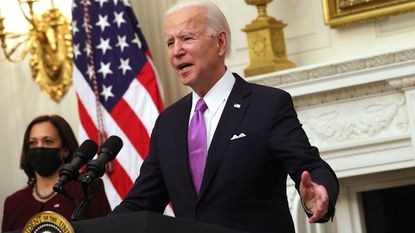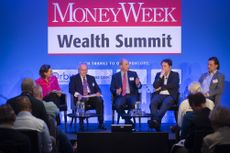Joe Biden’s spending spree will lift American spirits and markets – but it comes with a sting in the tail
New US president Joe Biden is planning to throw trillions of dollars in stimulus at his country’s economy. Markets will love that. But it comes with a catch, says Merryn Somerset Webb: rampant inflation.


Imagine you are a global equity investor. You look to America and see stockmarkets at or near record levels on every measurement; you see a global health pandemic, which the US appears to be managing particularly badly; and you see a nasty economic contraction, which has floored the retail and hospitality sectors and wreaked havoc on the labour market.
At the same time, a new president is being sworn in, one who looks likely to back a barbed bundle of regulation for the tech giants that are driving overvaluation; one who has promised sharp rises in taxation (these could take 5%-10% off the earnings per share of S&P listed companies, says Luca Paolini of Pictet Asset Management); and one who has outlined a budget-busting spending programme.
Stockmarkets do seem to love Joe Biden – so far
With US public debt already near $28trn, at any other time in market history you might have looked at that list of misery and sold up, sharpish. But this time that would have been a bad idea (in the short term, at least). Last Wednesday, Biden’s inauguration day, turned out to have been the best for the stockmarket since Ronald Reagan’s inauguration day 36 years ago. The S&P 500 hit a new high, as did the Nasdaq, which was up 2% on the day.
Subscribe to MoneyWeek
Subscribe to MoneyWeek today and get your first six magazine issues absolutely FREE

Sign up to Money Morning
Don't miss the latest investment and personal finances news, market analysis, plus money-saving tips with our free twice-daily newsletter
Don't miss the latest investment and personal finances news, market analysis, plus money-saving tips with our free twice-daily newsletter
You can argue that this makes sense. Biden’s win means that a new political order is moving into the White House, the House of Representatives and the Senate. There will (we hope) be no more erratic government by Twitter. Instead, we will see a return to normal levels of stability in US politics, bearing in mind that no country is ever actually united and no number of fine words can make the US different. That domestic stability should make international politics a little less fraught. The US is all set to re-engage with every global acronym out there from the WHO to the WTO and Nato.
Biden is also working to get on top of the pandemic. He has mandated mask-wearing and social distancing in all federal buildings and has promised to move heaven and earth to get 100 million vaccines done in his first 100 days. Assuming a two-jab regime, that’s only one in six or so of the US population but nonetheless, if targeted, it can cover most of the over-70s and the frontline workers needed to give the country enough immunity to be on the move again before the summer. All good.
It’s all about the money
But the truth is that the relentless jolliness of the market in the face of every misery chucked at it is not really about these things. It’s about something less empathetic: the money. Biden’s additional Covid-19 package comes to $1.9trn – on top of the $1trn or so promised in December – and is very heavily geared towards households.
Most Americans will get cheques for $1,400 and there will be an extra $400 a week chucked in from the federal government to supplement state unemployment benefits. Add that up and it should be enough to at least offset the incomes lost to the pandemic so far. It also replaces income likely to be spent: Americans, just like the British, are suffering from severe cabin fever and pent-up demand syndrome. The $1.9bn might be just the beginning.
Next month, Biden is to outline his “build back better” recovery plan. If you go by his campaigning, this should come to another $2trn or so. He can count on support from his new Treasury secretary, Janet Yellen, who told the Senate finance committee this week that, “right now with interest rates at historic lows the smartest thing we can do is act big”.
Add in the fascinating discussions about debt forgiveness – Biden has extended the student loan repayment pause until October – and it looks like we are about to see round after round of deficit-financed fiscal stimulus over the next few years. That’s nice. One of the big market worries has been that as the pandemic tails off so will fiscal support. I think we can let that one go.
All this stimulus will mean higher growth. Yardeni Research is now forecasting a 5.4% rise in US GDP this year, after a decline of 3.4% last year, something that would mean the US will have recovered from the recession of the first half of last year by the first quarter of this – the fastest recession and the fastest recovery ever. It also means that earnings will look good, which makes valuations look less bad and so drives equity market momentum.
All this stimulus can only mean one thing: inflation
However, the other thing it is likely to mean is inflation. US firms and households have cash piles. The US savings rate is still way above normal at 12.9%. As the vaccines start to work, individuals will start to spend and companies will rebuild the inventories they have been drawing down over the past year. Most economists will now tell you there may be a little inflation this year as the effects of last year’s energy price collapse work their way through the numbers and lockdown ends. This is now consensus.
They may be surprised to find that there is more than a little. As Christopher Wood of US investment bank Jefferies points out, there is every reason to think that the past year has taken significant capacity out of the system (check out how many restaurants around you have disappeared) and “whether it is rising DRAM [computer memory chip] prices or indeed resurgent shipping rates, there is a lot of evidence of supply constraints in the system”.
Commodity prices, soft and hard, are also rising sharply. The key thing to note here is that once inflation gets going it may just keep going. With $8tn debt to roll over this year and Yellen (and presumably Biden) keen to spend, spend, spend into low interest rates, the Fed is more likely to let inflation rise than to let interest rates rise.
What do you do in this environment? For now, appreciate it. But bear this in mind as you do: the market isn’t on the up because Biden is an obviously nicer guy than Trump. It’s because he is promising more money.
• This article was first published in the Financial Times
Merryn Somerset Webb started her career in Tokyo at public broadcaster NHK before becoming a Japanese equity broker at what was then Warburgs. She went on to work at SBC and UBS without moving from her desk in Kamiyacho (it was the age of mergers).
After five years in Japan she returned to work in the UK at Paribas. This soon became BNP Paribas. Again, no desk move was required. On leaving the City, Merryn helped The Week magazine with its City pages before becoming the launch editor of MoneyWeek in 2000 and taking on columns first in the Sunday Times and then in 2009 in the Financial Times
Twenty years on, MoneyWeek is the best-selling financial magazine in the UK. Merryn was its Editor in Chief until 2022. She is now a senior columnist at Bloomberg and host of the Merryn Talks Money podcast - but still writes for Moneyweek monthly.
Merryn is also is a non executive director of two investment trusts – BlackRock Throgmorton, and the Murray Income Investment Trust.
-
 Barclays warns of significant rise in social media investment scams
Barclays warns of significant rise in social media investment scamsInvestment scam victims are losing an average £14k, with 61% of those falling for one over social media. Here's how to spot one and keep your money safe
By Oojal Dhanjal Published
-
 Over a thousand savings accounts now offer inflation-busting rates – how long will they stick around?
Over a thousand savings accounts now offer inflation-busting rates – how long will they stick around?The rate of UK inflation slowed again in March, boosting the opportunity for savers to earn real returns on cash in the bank. But you will need to act fast to secure the best deals.
By Katie Williams Published
-
 Halifax: House price slump continues as prices slide for the sixth consecutive month
Halifax: House price slump continues as prices slide for the sixth consecutive monthUK house prices fell again in September as buyers returned, but the slowdown was not as fast as anticipated, latest Halifax data shows. Where are house prices falling the most?
By Kalpana Fitzpatrick Published
-
 Rents hit a record high - but is the opportunity for buy-to-let investors still strong?
Rents hit a record high - but is the opportunity for buy-to-let investors still strong?UK rent prices have hit a record high with the average hitting over £1,200 a month says Rightmove. Are there still opportunities in buy-to-let?
By Marc Shoffman Published
-
 Pension savers turn to gold investments
Pension savers turn to gold investmentsInvestors are racing to buy gold to protect their pensions from a stock market correction and high inflation, experts say
By Ruth Emery Published
-
 Where to find the best returns from student accommodation
Where to find the best returns from student accommodationStudent accommodation can be a lucrative investment if you know where to look.
By Marc Shoffman Published
-
 Best investing apps
Best investing appsWe round up the best investing apps. Looking for an easy-to-use app to help you start investing, keep track of your portfolio or make trades on the go?
By Ruth Emery Last updated
-
 The world’s best bargain stocks
The world’s best bargain stocksSearching for bargain stocks with Alec Cutler of the Orbis Global Balanced Fund, who tells Andrew Van Sickle which sectors are being overlooked.
By Andrew Van Sickle Published
-
 Revealed: the cheapest cities to own a home in Britain
Revealed: the cheapest cities to own a home in BritainNew research reveals the cheapest cities to own a home, taking account of mortgage payments, utility bills and council tax
By Ruth Emery Published
-
 UK recession: How to protect your portfolio
UK recession: How to protect your portfolioAs the UK recession is confirmed, we look at ways to protect your wealth.
By Henry Sandercock Last updated